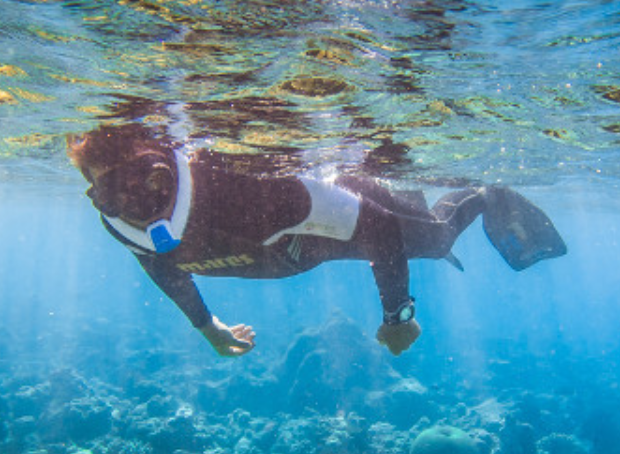Hur kommer dykeriet att utvecklas? Det är svårt att förutspå, det finns ju så mycket som kan förändras. Det kan röra sig om nya gasblandingar och därmed nya dyk eller djuptider. Produktutvecklingar som ger en bättre och/eller säkrare/djupare dykupplevelse. Eller kanske något som vi inte ens kan gissa oss till. Som en avslutning, eller kanske fortsättning, på Dykningens Historia presenterar vi här några nya uppfinningar som vi inte tagit med beroende av att vi antingen inte förstått hur de fungerar, vad som är nyttan med dem, eller kunnat få bekräftat att de verkligen existerar. Kanske någon av våra läsare kan ge klarhet. Kanske kommer vi också att finna någon av dessa innovationer bland Dyktankhusets samlingar i framtiden.
Uranus Nitroxsnorkel

In 1996 this snorkel was presented at the Tec-Asia 96 Conference in Singapore. Unlike modern conventional snorkels, the top of the ”Uranus” curves downwards and is fitted at its end with an open ”cage” that houses the microchip sensor unit in a ping-pong-shaped instrument that automatically switches the mix to 21% oxygen at the surface. This is where our doubts about the usefulness come in, because a snorkel can only be used close to the surface and normal air contains roughly 21% oxygen. However, the company behind the idea says that already in 1997 they expect to have produced a snorkel that can provide 20-51% oxygen. We have found websites that claim to sell Uranus, but still feel unsure about the product. Can you help us further?
O’DIVE

O’DIVE is a decompression analysis sensor.
A French innovation, an analyzer intended to be used for personal decompression calculation. To do this, a team of experienced engineers worked for many years on the issue of designing a unique and patented technology consisting of an acoustic sensor connected to a smartphone application and a server with specialized data analysis and processing. O’Dive is, according to the company, very easy to use When your dive is complete, the sensor is placed under the collarbone and takes two measurements 20 seconds apart. When the analysis is complete, it is sent to O’Dive’s servers for analysis and then returned to your application. It is up to you to evaluate and improve your diving conditions to minimize the risk of decompression sickness. The price is stated at 590 Euro. You can read more about O’DIVE at O’DIVE
FIFISH V6

AMPHI

Amphi is a monofin with a built-in motor that ”pushes” the swimmer through the water. It is a hybrid propulsion, powered partly by human muscles and partly by electric propellers, the same concept as an electric bicycle, but for use underwater. The swimmer/diver attaches their feet to the Amphi unit and can smoothly transition between muscle-powered and electric propulsion. Amphi detects the force of the kick and adds or subtracts the force accordingly. This allows the person to go between aggressive, sporty machine and relaxed cruising buddy. All according to the manufacturer. Amphi Americas recently unveiled its working prototype. The company is gearing up for an Indiegogo crowdfunding campaign. Consumer price has not yet been determined. Read more about Amphi at Amphi
IBUBBLE

Ibubble is a French innovation, an AUV, or automatic underwater drone with somewhat special features. The product is designed to take ”selfie movies” underwater. When Ibubble is dropped into the water, it automatically searches for a diver (can also be set for fish) and follows and films the object for up to an hour and down to a depth of 65 meters. If Ibubble were to run into problems, such as low battery, it would automatically rise to the surface. The product is not ready for delivery yet, but can be pre-ordered. The price is set at 4490 Euro. You can read more about this AUV at Ibubble
Paralenz

Paralenz looks like a miniature lamp, but is a UV camera. waterproof down to 250 meters and with automatic color correction depending on depth. The camera can also be attached very easily to, for example, the cyclops. Estimated price, 749 Euro. Read more about Paralenz at Paralenz
AMEO POWERBREATHER

A representative of the new snorkel generation
Are you tired of your snorkel constantly filling up with water? Do you want to constantly breathe fresh air? The Ameo Powerbreather snorkel is the solution to both of these questions. With its new system of waterproof valves, water cannot enter the snorkel channel. In addition, the air transported is fed by two channels, one for inhalation and one for exhalation. You are thus guaranteed fresh air that is not loaded with carbon dioxide. Ameo is available in various designs and costs from 89 Euro. If you want to know more about Ameo, go to Ameo Powerbreather
Seabike

Are you one of those people who think that this thing about getting around underwater with fins is hopelessly old-fashioned? Then the Russian company Seabike may have come up with the solution for you, a propeller-driven underwater bike. The price is set at 399 Euro and you can read more about the creation at Seabike
FinClip

Everyone has at some point experienced trouble with putting on the fins. Now the solution to the problem is finally here.
With FinClip, you put on the fins much like a pair of skis. The price is set at 69 Euro and you can read more about the product at FinClip
Hydroid Aquabreather

The big news during DEMA 2019 was the Hydroid Aquabreather, developed by the Russian company Aquabreather LLC. A type of diving helmet equipped with two replaceable cartridges for breathing supply. The cartridges contain sodium superoxide and potassium superoxide. The helmet is thus a kind of closed rebreather system. The company, Hydroid claims that the helmet removes the dependence on air supply from the surface and diving bottles and also claims that the helmet, with cartridges, can be used to a diving depth of 42 meters for 60 minutes. The weight of the helmet is stated to be 4.5 kilos. A major advantage of the helmet, which the company highlights, is that you avoid the problem of air bubbles. A ”heads up display” in the glass shows the partial oxygen pressure. Both visual and audible alarms start when the oxygen pressure falls below a certain level.
You can watch a film from the presentation at DEMA 2019 here and the company’s own promotional film here, (scroll down). Now at the end of 2020, the product does not yet appear to be fully developed, but you can pre-order an Aquabreather Hydroid from the company’s website, http://aquabreather.com/en/buy/, however, neither price nor delivery date is specified.
Supa Huka

Behind this product is a Canadian so-called kickstart company with the same name as the product. The system consists of a floating bag, equipped with two batteries and a solar-powered air pump connected to a 10-meter spiral hose that ends with a demand valve. A vest with an automatic valve and a reserve air system as well as a mount for a UV camera are also included. The system is equipped with a visual and audible alarm for low battery level. All packed in a cabin-sized bag with a small space for, for example, a cyclops and a towel. The company specifies 10 meters as the maximum diving depth and the action time as two hours, but recommends a maximum diving time of 45 minutes. You can find a film about Supa Hukahere
The product was supposed to be launched in 2020, but has suffered several delays. The latest, reported in mid-June 2020, said it consisted of problems with a Chinese subcontractor. The system is priced at $600 for pre-order.
(Editor’s note) So-called hookah diving systems where air is supplied from floating and mobile small platforms are nothing new, they started coming onto the market already in the 1970s. Several of them have connections for up to four divers. In most cases, the diving depth is limited to 10 meters, but there are those that manage to supply two divers with air at a depth of 25 meters, or one diver down to a depth of 40 meters. The basis of the Hookahdiving system was actually presented by the Dean brothers back in 1820.
Scubus 5

Scubus 5 is a cyclops with fog-free glass, Headup display in the glass and HD camera. We have not yet found anything that points to how far this cyclops has progressed.
These were the products we found that tickled the imagination the most, maybe there are more. What do you think? Will any of these be in the Dive Tank House collections in a few years or will they never come to market? Maybe you have your own wish about what the next big innovation in diving would be? Write and tell.
/div